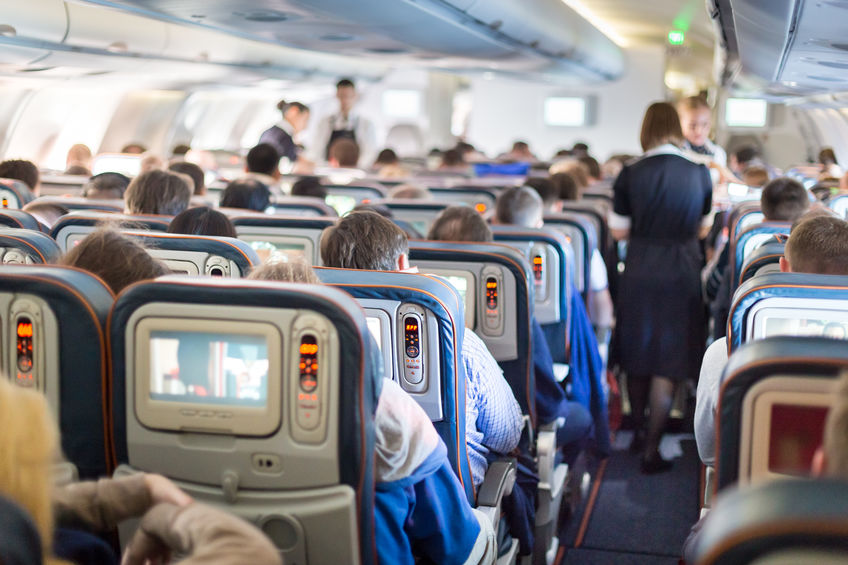Just over a year ago, newly elected U.S. Rep. Alexandria Ocasio-Cortez (D, NY) and U.S. Sen. Edward Markey (D, MA) shocked the world by proposing a Green New Deal. One of its more controversial provisions was a proposal to “build out high-speed rail at a scale where air travel stops becoming necessary.”
UBack in 2013, Elizabeth Rosenthal, writing in The New York Times, stated that air travel is the “most serious environmental sin” for many Americans. A single round-trip flight from New York to Europe or San Francisco adds 2 or 3 tons per person of carbon dioxide to the atmosphere, she noted, and added that air travel emissions are rising (relatively speaking, at least) because the volume of air travel is increasing much faster than gains in flight fuel efficiency (while emissions from other sectors are falling).
The website “Green Choices” calls air travel “one of the most greenhouse-gas rich forms of transport in existence,” and laments that the lack of fuel duty on aviation fuel is a subsidy that makes air travel “surprisingly cheap.” In addition to carbon dioxide, air travel generates nitrogen oxides and water vapor that also contribute to the greenhouse effect. In their view, growth in the aviation industry is incompatible with efforts to combat climate change.
The European Union brought aviation into its emission trading system in 2012, but protests from China, the U.S., and other countries confined that program to intra-EU flights through 2024. But Transport & Environment, which bills itself as “Europe’s leading clean transport campaign group,” claims that the aviation sector has a climate impact that “continues to spiral out of control” with “no sign of abating”
Over in the United Kingdom, which just left the EU, decades-old plans to build a third runway at London’s busy Heathrow Airport ran into yet another roadblock at the United Kingdom’s Court of Appeal ruled that the runway proposal was “illegal” because it did not take into consideration the government’s climate change commitments.
London Mayor Sadiq Khan and his environmentalist allies cheered the decision, which Heathrow Airport Holdings (but not the British government) promises to appeal to the country’s Supreme Court. Khan has long condemned the plans for a third runway, calling it “the wrong decision for London and the whole of Britain” and claiming its construction, and the increased number of flights it would allow, would be “devastating for air quality across London.”
Even if Heathrow wins the right to build its third runway at some time in the future, the delays brought about in large part thanks to the nation signing onto the Paris climate agreement will surely raise the price of construction – not to mention postpone revenues from landing fees that otherwise would already be kicking in.
The much-needed runway would increase capacity at the airport from 85.5 million passengers a year to 130 million and increase the annual total flights from 474,000 to 740,000. The new runway would result in up to $228 billion in economic growth across the United Kingdom and create up to 180,000 new jobs nationwide – all at a cost estimated at under $20 billion.
The Confederation of British Industry in June 2018 had lauded the decision by then-Prime Minister Theresa May and her full cabinet to approve the airport expansion, which is NOT favored by current Prime Minister Boris Johnson. Josh Hardie, CBI deputy director-general, has stated that “Our aviation capacity is set to run out as early as 2025, so it’s crucial we get spades in the ground as soon as possible.”
Meanwhile, China in 2018 announced plans to build 216 NEW airports by 2035 to meet “the growing demands for air travel,” almost doubling the number of airports in that country today. The country (pre-corona virus) in 2017 had 552 million air passengers.
India, too, has embarked on a massive plan to build 100 new airports by 2024 as part of a plan to revive economic growth. The plan, conceived by India’s state think tank, also includes doubling the domestic aircraft fleet, training 600 new pilots a year, and upgrading existing runways, many of which date to World War II. Just four years ago, only 75 of the nation’s 450 runways were operational.
Those who hope we can replace jet engines with clean energy will be sad to learn that, while there is such a thing as a solar airplane, they are slow (maximum speed 100 kilometers per hour), unable to carry an airplane full of passengers, heavily dependent upon good weather, and provide very narrow margins of error for pilots.
As Dan Reed explained in a 2019 Forbes op ed, applying the Green New Deal just to air travel would devastate to the U.S. economy and only address the 3.5 percent of greenhouse gas emissions attributable to air travel. The proposal threatens the jobs of the nation’s 700,000-plus airline employees (whose average salary in 2016 was about $86,000), and severe cutbacks in air travel would also impact industry vendors, airports, cargo forwarding companies, hotels, and other travel-related companies.
Such an action by the U.S. would also threaten the U.S. dominance in aircraft manufacturing technology as well as advanced aviation and aerospace technology, development, and aircraft design and production, Reed added.
While shuttering the airline industry sounds out of the realm of possibility, it must not be forgotten that 67 members of Congress cosponsored the AOC-Markey Green New Deal resolution, including Democratic front-runner Sen. Bernie Sanders (I, VT). Sanders later introduced his own (scaled-down) Green New Deal proposal that would surely be but a first step toward full implementation of the radical plan to transform America away from prosperity.
